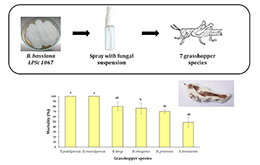Control capacity of the LPSc 1067 strain of Beauveria bassiana (Ascomycota: Hypocreales) on different species of grasshoppers (Orthoptera: Acrididae: Melanoplinae), agricultural pests in Argentina
DOI:
https://doi.org/10.48162/rev.39.099Palabras clave:
Grasshoppers, Entomopathogenic fungi, Biocontrol, Beauveria bassiana, pestsResumen

Grasshoppers affect agriculture worldwide, causing serious economic damage. Currently, the application of chemical insecticides against grasshoppers is the only effective strategy, even considering the significant environmental concern. This study aimed to test the entomopathogenic fungi Beauveria bassiana (LPSc 1067) as biocontrol agent on six harmful grasshopper species in Argentina. Significant differences were observed (DF= 5; F= 9.93; P<0.0001) when considering B. bassiana pathogenicity on third-instar nymphs of the different grasshopper species. The highest mortality (100%) was registered on Trimerotropis pallidipennis and Dichroplus maculipennis nymphs while the lowest mortality (48.6 ±3.5%) was observed on Scotussa lemniscata nymphs. The lowest mean survival time (MST) was recorded for T. pallidipennis (3.5 ±0.15 days) and the highest MST was observed on Dichroplus pratensis nymphs (7.48 ±0.28 days). Results suggest that B. bassiana LPSc 1067 may constitute an excellent candidate to be further studied as biological control agent of T. pallidipennis and D. maculipennis.
Highlights:
- Melanoplinae grasshoppers include several species considered plagues.
- Entomopathogenic fungi as biocontrol agents are considered excellent alternatives to chemical control.
- The efficacy of bassiana (LPSc 1067) on six grasshopper species of Argentina.
- The isolate LPSc 1067 could be considered a biological controller pallidipennis and D. maculipennis.
Descargas

Descargas
Publicado
Cómo citar
Número
Sección
Licencia
Derechos de autor 2018 Revista de la Facultad de Ciencias Agrarias UNCuyo

Esta obra está bajo una licencia internacional Creative Commons Reconocimiento-NoComercial-CompartirIgual 3.0.
Aquellos autores/as que tengan publicaciones con esta revista, aceptan las Políticas Editoriales.










.jpg)




